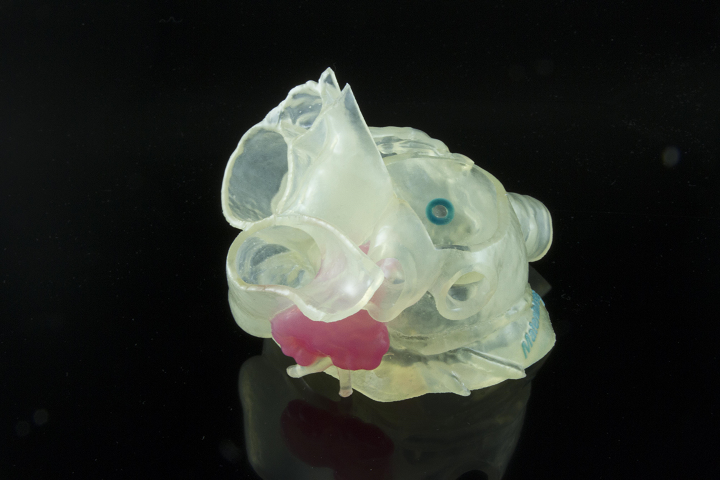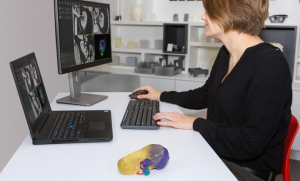This spring, Materialise became the first company ever to get FDA clearance for software about 3D printing anatomical models for diagnostic use; to this day, it remains the only end-to-end 3D printing solution with 510(k) clearance. Now, Stratasys is expanding its suite of 3D printers and materials that have been officially validated by Materialise as part of its FDA-approved Materialise Mimics inPrint software, resulting in a versatile 3D printing system for point-of-care.
Due to this collaboration between Materialise software and Stratasys PolyJet 3D printing, the production of 3D printed patient-specific anatomical models for diagnostics can continue to advance. Physicians can combine this solution with other tools and their own expect judgement to build highly accurate anatomic models for patients at the point-of-care. According to the company, 16 of the top 20 hospitals in the US, as ranked by U.S. News & World Report, are using Materialise Mimics software as a medical 3D printing strategy…and this number could go up, thanks to the company’s new collaboration with Stratasys.“By validating Stratasys’ 3D printing technologies through our certification process, we’re giving doctors and hospitals improved access to high-quality anatomical models for personalized care to patients. The addition of multi-color and multi-material printers to the list of validated printers is aimed to enable healthcare providers to implement a versatile offering that can support their most complex cases across a wide range of surgical specialties on a single printer,” said Bryan Crutchfield, the Vice President and General Manager of Materialise North America. “At Materialise, we take a hardware-agnostic approach to software development, offering the flexibility to partner with other leaders in the 3D printing industry like Stratasys – a company committed to addressing requirements of the medical community.”
Stratasys PolyJet multi-color and multi-material 3D printing solutions that have been validated by Materialise now included its high-performance Objet30 Prime, along with its multi-color J735 and J750 3D printers. The Objet30 Prime. The cost-effective Objet30 Prime is a versatile desktop platform that can support multiple anatomical models and applications, such as cardiac, neurosurgery, and orthopedic, along with use-cases for education, surgical planning, training, and visualization. It’s the perfect system to give hospitals a foot in the door to point-of-care 3D printing.“Historically, pre-surgical planning relied on 2D imaging requiring physicians to mentally reconstruct the patient anatomy. But 3D printing evolves this approach by putting precise replicas of patient anatomy directly in physician hands,” explained Eyal Miller, the Head of Healthcare Business Unit, Stratasys. “Our collaboration with Materialise is a huge step towards unlocking the potential of this technology for patient care. Now the 3D printer that every hospital needs to power their medical modeling comes with additional options for an FDA-cleared software solution.”
The multi-color, multi-material Stratasys J735 and J750 3D printers can both create complex models with multiple textures, and can also mimic human tissue by combining both soft and hard materials. This helps doctors and other medical practitioners fabricate realistic replicas of bone, organ, and tissue, while also differentiating between different anatomy and getting a closer look at the critical structures inside an organ replica.
 At RSNA 2018, which ends on Friday, Stratasys will be showcasing both its J750 and Objet30 Prime 3D printers. Visit Booth #1968L in the South Hall to see detailed customer use-cases, presentations, and exclusive hands-on demonstrations.
At RSNA 2018, which ends on Friday, Stratasys will be showcasing both its J750 and Objet30 Prime 3D printers. Visit Booth #1968L in the South Hall to see detailed customer use-cases, presentations, and exclusive hands-on demonstrations.
What do you think? Discuss this news and other 3D printing topics at 3DPrintBoard.com or share your thoughts in the Facebook comments below.
Subscribe to Our Email Newsletter
Stay up-to-date on all the latest news from the 3D printing industry and receive information and offers from third party vendors.
Print Services
Upload your 3D Models and get them printed quickly and efficiently.
You May Also Like
Making 3D Printing Personal: How Faraz Faruqi Is Rethinking Digital Design at MIT CSAIL
What if your 3D printer could think more like an intelligent assistant, able to reason through a design idea, ask questions, and deliver something that works exactly the way the...
Reinventing Reindustrialization: Why NAVWAR Project Manager Spencer Koroly Invented a Made-in-America 3D Printer
It has become virtually impossible to regularly follow additive manufacturing (AM) industry news and not stumble across the term “defense industrial base” (DIB), a concept encompassing all the many diverse...
Heating Up: 3D Systems’ Scott Green Discusses 3D Printing’s Potential in the Data Center Industry
The relentless rise of NVIDIA, the steadily increasing pledges of major private and public investments in national infrastructure projects around the world, and the general cultural obsession with AI have...
Formlabs Teams Up with DMG MORI in Japan
In late June, Nick Graham, Chief Revenue Officer at Formlabs, announced on LinkedIn that the company had partnered with DMG MORI, one of the world’s leading machine tool companies, to...




































